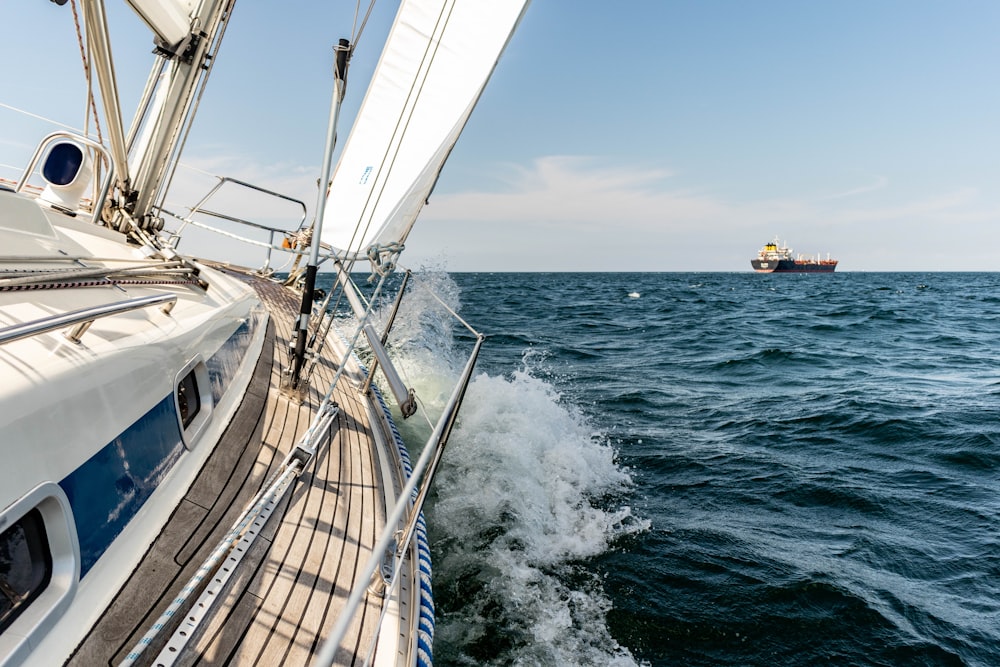‘Power gives way to sail’ is a commonly used phrase amongst mariners and sailors alike, however it isn’t always true. There are less obvious details in the COLREGS that tell a different story to the one you might expect. This post describes the nitty-gritty details in simple and easy to understand terms. The aim here is to make sure you know the answers next time you are at sea or under assessment.
Let’s start by looking at the part of the COLREGS the describes the responsibility between different types of vessels.
Responsibilities between vessels (Rule 18)
This rule tells us in very clear terms that a power-driven vesselThe term 'power-driven vessel' means any vessel propelled by machinery. ‘shall keep out of the wayRule 16 Action by give way vessel - Every which is directed to keep out of the way of another vessel shall, so far as possible, take early and substantial action to keep well clear. More of’ … ‘a sailing vessel’. But as with most elements of the COLREGS there are exceptions that you need to know about. The most important part of Rule 18 be found in the first sentence.
Rule 18: Responsibilities between vessels
Except where Rules 9, 10 and 13 otherwise require:
So what are these other rule and how do we apply them? To start with let’s look at the rule titles.
- Rule 9: Narrow Channels
- Rule 10: Traffic Separation Schemes
 A traffic separation scheme (TSS) is similar to a highway at sea. A TSS is often made up of 'traffic lanes' and 'separation zones' which prevent vessels from meeting head on and therefore reduce the likelihood of collision. It is common to find traffic separation schemes in areas of high traffic density such as straits and choke points. The rules relating to traffic separation schemes are described in Rule 10. More
A traffic separation scheme (TSS) is similar to a highway at sea. A TSS is often made up of 'traffic lanes' and 'separation zones' which prevent vessels from meeting head on and therefore reduce the likelihood of collision. It is common to find traffic separation schemes in areas of high traffic density such as straits and choke points. The rules relating to traffic separation schemes are described in Rule 10. More - Rule 13: Overtaking
Without going too deep into the details, we now know that in the scenarios above rule 18 might not apply. If you are trying to learn the COLREGS this is an important point to make a note of. The rules mentioned above are commonly used when driving ships close to the coast and included in assessments.
When does power not give way to sail?

Imagine a busy port with lots of large merchant vessels arriving and departing through a channel. As the large vessels move around a port they have to stay in deep water and avoid navigational dangers. During this time they have limited ability to avoid other vessels and it can become difficult to apply rule 18.
Rules 9 & 10 tell sailing vessels ‘not to impede’ vessels that can ‘only safely navigate within a narrow channel’ and/or a ‘ power-driven vesselThe word 'vessel includes every description of water craft, including non-displacement craft, WIG craft and seaplanes, used or capable of being used as a means of transportation on water'. following a traffic lane’. For a more detailed explanation of these types of situations see our rule 8 (f) explained post.
Another occasion when a sailing vesselThe term 'sailing vessel' means any vessel under sail provided that propelling machinery, if fitted, is not being used. might be required to keep out of the way is when she is overtaking. This is an uncommon situation as sailing vessels don’t often go faster than power-driven vesselsThe term 'power-driven vessel' means any vessel propelled by machinery. More. However when a sailing vessel is overtaking any other vessel (including a PDV) she ‘shall keep out of the way of the vessel being overtaken’.
Key points
Power does not always give way to sail. Although the Responsibilities between vessels rule applies in most scenarios we need to consider if there is a narrow channel, traffic separation schemeA traffic separation scheme (TSS) is similar to a highway at sea. A TSS is often made up of 'traffic lanes' and 'separation zones' which prevent vessels from meeting head on and therefore reduce the likelihood of collision. It is common to find traffic separation schemes in areas of high traffic density such as straits and choke points. More or overtaking situation that may cause other aspects of the rules to come into play.
Are you studying for a COLREGS exam? Check out our study app it’s a quick and easy tool that helps you remember the rules.

